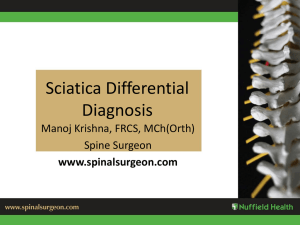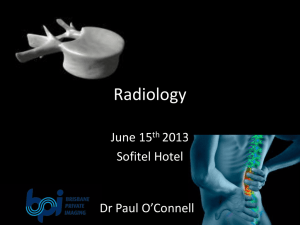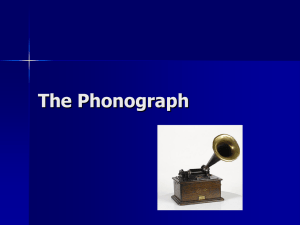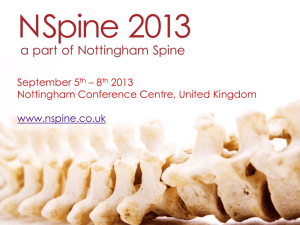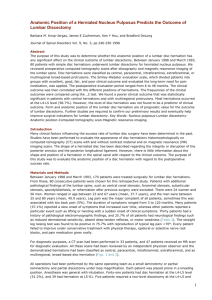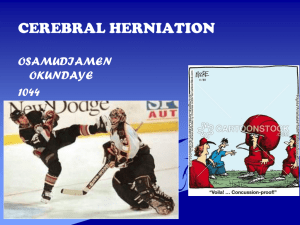ppt - Click here to
advertisement
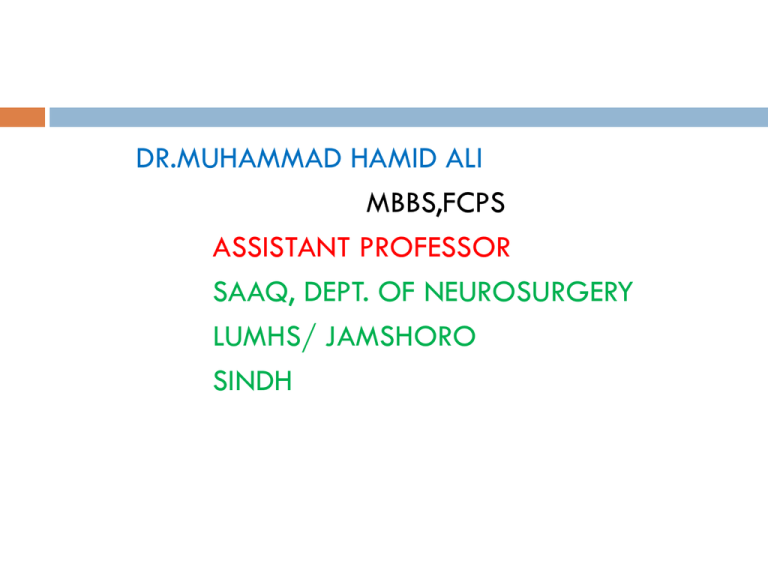
DR.MUHAMMAD HAMID ALI MBBS,FCPS ASSISTANT PROFESSOR SAAQ, DEPT. OF NEUROSURGERY LUMHS/ JAMSHORO SINDH LOW BACK Five lumbar vertebrae Fibrocartilaginous discs b/w the (cushions, protection) ligaments and muscles (stability) facet joints (limits & directs spinal motion) multifidus muscles (keep spine straight & stable in movements) LOW BACK PAIN(LBP) COMMON PROBLEM → 80% population NO SPECIFIC CAUSE → 85% cases SYMPTOM not 2ND MOST COMMON 15% all sick leave 1% pt: 1 – 3% pt: → 90% pt: improve in one month 80% pt: of sciatica improve with or without surgery AN ILLNESS reason to seek medical advise → nerve root symptoms lumbar disc herniation CLASSIFICATION ACUTE LBP SUB-ACUTE LBP CHRONIC LBP CLASSIFICATION Majority has DEGENERATIVE Degenerative disc Spinal osteoarthritis Spinal stenosis MECHANICAL(MUSCULOSKELETAL/NON-SPECIFIC) disorders Myofascial disease Fibromyalgia DEGENERATIVE TYPE CLSSIFICATION Minority has NON-DEGENERATIVE LBP Metabolic Inflammatory Infectious Neoplastic REFERRED PAIN From other parts of body AHCPR classification Potentially serious spinal condition Spinal tumors Spinal infections Fractures Cauda equina syndrome Non-specific back symptoms Symptoms suggesting neither nerve compression nor a potentially serious condition AHCPR classification Sciatica Back related lower limb symptoms suggesting nerve root compression ASSESSMENT Initial assessment is geared to detecting “red flags” Pts: with LBP, fever, weight loss, continuous stiffness, acute bone pain &pain at rest needs to investigate for “red flags” INITIAL ASSESSMENT History Age > 50 years Previous Ca Unexplained weight loss Failure to improve after 1 month therapy Pain more than 1 month Immunosuppression Pain worse at night → favor neoplastic lesion INITIAL ASSESSMENT History Skin infection Iv drug abuse UTI or other infection → favor spinal osteomyelitis -age > 50 or 70 years - trauma - steroids - bone pain → favor compression fracture INITIAL ASSESSMENT History -LBP radiating to legs - numbness in legs - weakness in legs → favors herniated lumbar disc(sciatica) Age > 50 years Pain or numbness on walking → favors spinal stenosis INITIAL ASSESSMENT History Bladder dysfunction Saddle anesthesia → favors cauda equina syndrome Unilateral or bilateral leg weakness or pain Age < 40 years AM back stiffness Pain relieved on motion Pain > 3 months → favors ankylosing spondylitis INITIAL ASSESSMENT History Other factors Work status Typical job task Educational level Failed previous treatment Addiction depression INITIAL ASSESSMENT Physical examination More helpful in identifying spinal infection than spinal cancer Following findings favors spinal infection but may be common in pts: without infection Fever (common in epidural abscess & in osteomyelitis but less common in discitis Vertebral tenderness Very limited range of spinal motion INITIAL ASSESSMENT Physical examination Finding favoring neurologic compromise Weak dorsiflexion of ankle & big toe Weak planter flexion Diminished achilles reflex Diminished light touch sensation over medial malleolus & medial foot Diminished light touch sensation over dorsum of foot Diminished light touch sensation over lateral malleolus &lateral foot Scoliosis SLR & crossed SLR FURTHER EVALUATION Over 95% of cases of LBP In the initial 4 weeks of symptoms In the absence of any “red flags” conditions ↓ NO FURTHER TESTING RECOMMENDED Simple tests such as CBC and ESR along with x-ray of back should be obtained if any doubt exist relating to back tumor or infection FURTHER EVALUATION special tests are performed to evaluate non-degenerative and “red flags” conditions. They are divided into 2 groups 1:-Tests to detect physiological dysfunction A. to detect neurologic dysfunction: EMG, NCV, SEP… B. to detect non-neurologic diseases: CBC, ESR, UCE, U/S, CAL,VIT.D, phosphate, magnessium, parathyroid hormone level , alkaline phosphatase, acid phosphatase, BONE SCAN… 2:- Tests to demonstrate anatomy X-rays, CT, MRI, bone density, Myelography… CONSERVATIVE TREATMENT Indicated where there is no urgency for surgery or diagnosis is non-specific or in the absence of “red flags”. Based on recommendation by AHCPR panel and include the following ① BED REST:Bed rest not more than 4 days by reducing movements and reducing pressure on the nerve roots. ② AVTIVITY MODIFICATION:Tolerable physical activity to minimize disruption of daily activity. Avoid lifting heavy weight, prolonged bending & sitting or twisting of the back. COSERVATIVE TREATMENT ③ EXERCISE:low stress aerobic exercise, increase gradually for few weeks ④ ANALGESICS:NSIAD, opioids in severe pain ⑤ MUSCLE RELAXANTS:Reduce pain by relieving spasm ⑥ EDUCATION:Reassurance proper posture, lifting techniques COSERVATIVE TREATMENT ⑦ SPINAL MANIPULATION THERAPY (SMT):In acute LBP without radiculopathy ⑧ EPIDURAL INJECTIONS:Short term relief of radicular pain no t useful without radiculopathy MEDICAL MANAGEMENT Besides of above discussed measured one must see the basic cause of disease that may be treatable medically like in OSTEOMALACIA Oral ergocalciferol 0.05mg(2000 iu) U/ Violet rays if H/O malabsorption then 5mg(200000iu) or 40 to 80 thousands iu iv RT acidosis corrected with sodium bicarbonate MEDICAL MANAGEMENT OSTEOPOROSIS Ca supplement 1 to 2 gm/day Estrogen 0.625 mg/day for 3 to 4 weeks Progesterone 5-10 mg/day for last 10 days of estrogen Sodium fluoride 5 mg increases healing T/L braces Decrease alcohol and tobacco Increase exercise MEDICAL MANAGEMENT PAGET’ DISEASE Calcitonin 100 microgram/day with biophosphonate & mithramycin in resistant cases decompressive laminectomy in severe stenosis MEDICAL MANAGEMENT PYOGENIC INFECTION 6 weeks of intravenous antibiotics along with rest & immobilization GRANULOMATOUS DISEASES Anti-fungal Anti-tuberculous Antibiotics MISALLENIOUS Steroids and chemotherapeutic agents in tumors Interventional Treatment Options Neural blockade Neurolytic techniques radiofrequency neurotomies pulse radio frequency Stimulatory techniques selective nerve root blocks facet joint blocks, medial branch blocks spinal cord stimulation peripheral nerve stimulation Intrathecal medication pumps delivery into spinal cord and brain via CSF Physical Treatment Options Exercise (stabilization training) Neutral position Soft tissue mobilization Transcutaneous electrical nerve stimulation (TENS) Electrothermal therapy Complementary measures (acupuncture; relaxation/hypnotic/biofeedback therapy) Spinal manipulative therapy Multidisciplinary treatment programs (back schools/education/counseling/pain clinic) SURGICAL TREATMENT INDICATION for HLD:- Pts: with < 4 – 8 weeks of symptoms (A). those with “RED GLAGS” 0r progressive neurological deficit (B). Intolerable pain refractory to medical management Pts: with > 4 – 8 weeks of symptoms Sciatica that is both severe and disabling SURGICAL TREATMENT Routine HLD Discectomy foraminal or far lateral HLD partial or total facetectomy lumbar spinal stenosis decompressive laminectomy fracture/dislocation/instability lumbar spinal fusion (trauma, tumors, infections, spondylolisthesis) instrumentation and fusion Lumbar disc herniation Outlines Introduction Definition Causes Types of disc herniation Typical locations of disc herniation Clinical manifestations Diagnostic studies Management Nursing intervention Lumbar disc herniation Introduction Definition of disc herniation Abnormal rupture of the soft gelatinous central portion of the disc (nucleus pulposus) through the surrounding outer ring (annulus fibrosus). In about 95% of all disc herniation cases, the L4-L5 or L5-S1 disc levels are involved. Causes of lumbar disc herniation 1. 2. 3. Trauma or injury to the disc Disc degeneration Congenital predisposition Classification of LDH Degenerated: internal deterioration with loss of hydration and disc space Bulging: Circumferential symmetric extension beyond the end plates Protruded: focal or asymmetric extension beyond the interspace (broad connection b/w the disc & the protruded disc) Classification of LDH Extruded disc: (free fragment): more extreme extension Sequestered: free fragment contained by PLL Contained herniation: outer margin of anulus fibrosis is intact (more than a bulge) Types of disc herniation There are three types of disc herniation A. Protrusion / bulge B. Disc herniation C. Sequestration (disc rupture) Typical locations of disc herniation Central It is rare condition, it will affect multiple nerve roots, patient will have back pain more than leg pain and it may cause incontinence of the bladder and bowel. Urgent surgical treatment is necessary if patient presents with neurological deficits. Typical locations of disc herniation Posterolateral Usually it is the most common location, it involve one nerve root (the lower one). Foraminal It occurs in about 8-10% of all cases. It involves the exiting nerve. Clinical manifestations of disc herniation If the herniated disc is: Not pressing on a nerve, you may have an ache in the low back or no symptoms at all. Pressing on a nerve, you may have pain, numbness, or weakness in the area of your body to which the nerve travels. Clinical manifestations of disc herniation With herniation in the lower (lumbar) back, sciatica may develop. sciatica is pain that travels through the buttock and down a leg to the ankle or foot because of pressure on the sciatic nerve. Low back pain may accompany the leg pain. Clinical manifestations of disc herniation Leg pain caused by a herniated disc Usually occurs in only one leg. May start suddenly or gradually. May be constant or may come and go (intermittent). May get worse ("shooting pain") when sneezing, coughing, or straining to pass stools. Leg pain caused by a herniated disc (cont…) May be aggravated by sitting, prolonged standing, and bending or twisting movements. May be relieved by walking, lying down, and other positions that relax the spine and decrease pressure on the damaged disc. Clinical manifestations of disc herniation Nerve-related symptoms caused by a herniated disc include: Tingling ("pins-and-needles" sensation) or numbness in one leg that can begin in the buttock or behind the knee and extend to the thigh, ankle, or foot. Weakness in certain muscles in one or both legs. Pain in the front of the thigh. cauda equina syndrome Diagnostic studies MRI is the test of choice for evaluation of disc disease. Its multiplanar capabilities make it suitable for visualizing far lateral disc herniation as well as the paravertebral structures. Management of disc herniation The medical management traditionally involves: Bed rest and analgesics and anti-inflammatory drugs. Muscle relaxants help in some. Transcutaneous electrical nerve stimulation (TENS) helps in about 20% of patients. Physical therapy such as (exercise, relaxation, massage, and hot compressors). Management of disc herniation Surgical management: Indications for surgery include failure of acceptable pain control by nonoperative measures, progressive neurological deficit. The traditional approach to lumbar discectomy (laminectomy) usually under general anesthesia. Nursing intervention Reducing pain Bed rest Comfortable position such as semi-fowler's with moderate hip and knee flexion or side lying position. Progressive ambulation Patient's education Exercise Proper position Avoid lifting Summary Common problem Increasing disability Initial 4 weeks medically, physically More than 4 weeks and “red flags” Needs further evaluation refer to neurosurgeon Surgery has excellent result in sciatica THANKS

